In the afternoon of Wednesday April 25th, with the 2018 class in Performing Arts Practices and Management, part of the MACAM (MBA in Arts and Cultural Management) currirulum of the IESA, Paris, we visited La Gaîté Lyrique, "a cultural venue of the City of Paris," it says on their website's homepage, "devoted to the meeting between arts, technologies, and society". We were given a tour by Aurélie Sellier, directrice des publics.
After an overview of the rather curious history of the Gaîté site and building follows an English translation of the near to complete, unabridged and very litteral transcription of the (mainly francophonic) sound recording that we made of our visit, for use by the students as reference and lecture notes.
SoundBlog PAPAM entries:
(2020, november 10) - Zingaro, equestrian theatre (papam18_5)
(2019, december 22) - Rendez-vous Contemporains de Saint-Merry (papam19_2)
(2019, october 11) - STEIM, Amsterdam (papam19_1)
(2018, may 05) - La Gaîté Lyrique (papam18-4)
(2018, april 30) - IRCAM (papam18-3)
(2018, april 20) - Sonic Protest Festival (papam18-2)
(2018, april 10) - La Générale Nord_Est (papam18-1)
33 min read 🤓
La Gaîté Lyrique (papam18-4)
may 5, 2018.
__Some history_
Originally on the boulevard du Temple in the 11th arrondissement, the Théâtre de la Gaîté was founded in 1759, starting small, then growing bigger, in a theatre building that was replaced/rebuilt several times, in 1764, then in 1808, and again in 1835, when a fire broke out during a dress rehearsal.
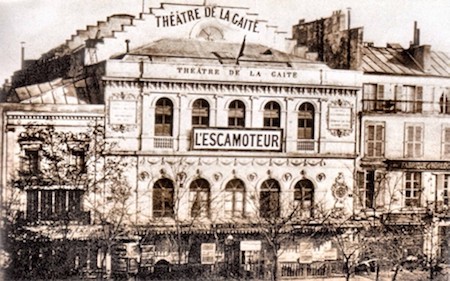 |
Less than thirty years later, in 1862, the new building was demolished as part of Baron Hausmann's renovation of Paris. The theatre then relocated to the rue Papin. Programming shifted from melodrama to operette and opera, and the theatre became known as the Gaîté Lyrique. It was at the rue Papin that in the 1920's Russian art critic, patron and ballet impresario Sergei Diaghilev’s Paris-bashed Ballet Russes performed some of its productions, many of which involved music commissioned from French composers like Stravinksy, Debussy, Satie, Poulenc, Milhaud, and collaborations with French visual artists like Picasso, Matisse, Derain or writer/designer/playwright Jean Cocteau.
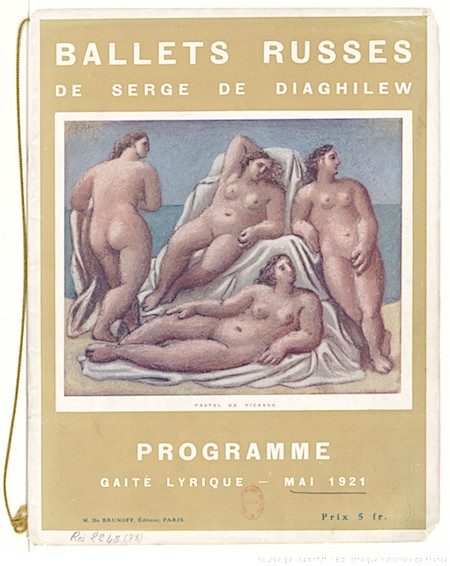 |
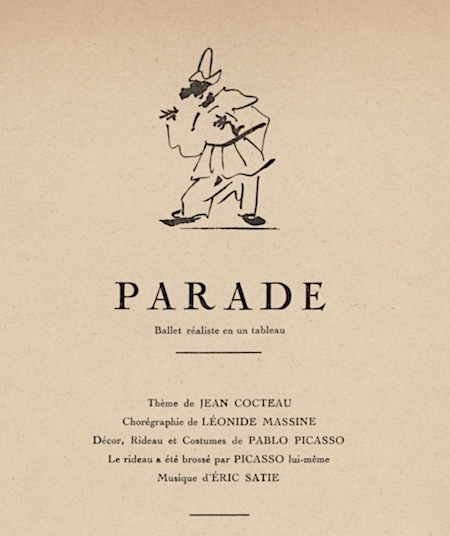 |
After World War II use of the theatre centred on the performance of (French) musical comedies. Financial problems force the theatre to close its doors in the early 1960's, with the building needing substantial restoration works that the city of Paris is unwilling to fund. In the early 1970's the building is mainly used by Cirque Gruss, a circus school, that - according to some sources - converted the theatre's attic into stables for elephants (!).
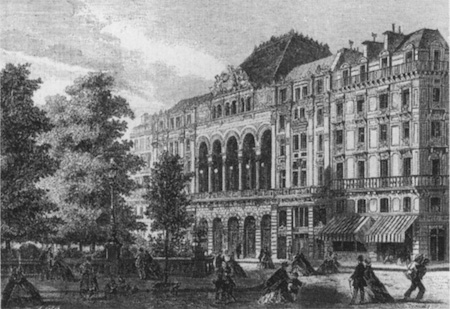 |
Planète Magique ( * )
The necessary restoration works keep being postponed, and as off 1977 the theatre building is abandoned. Jean Chalopin, a French producer and the inventor of popular television cartoons like Inspector Gadget, then dreams up a use for La Gaîté even wilder than elephant stables. In 1983 he proposes the city of Paris to transform the 1100 m2 seven-floor theatre building (that around the same time is classified as a historical monument) into an American style indoor amusement park for kids: Planète Magique!
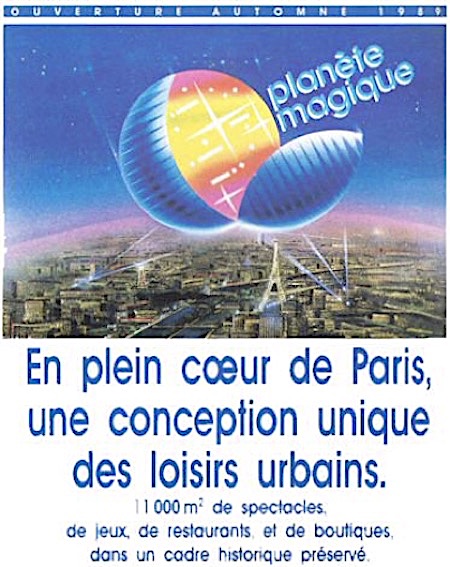 |
After a lot of administrative/financial/bureaucratic dealing and wheeling, in 1986 the later president of France and then mayor of Paris, Jacques Chirac, gave permission for the project, to be executed by two brand new companies, founded for that end: the SA Planète Magique and the S.E.G.L. (Société d'exploitation de la Gaîté-Lyrique), a business web spun by and around mr. Chalopin and his partners.
The budget is around 43 million euros (280 million francs). The city of Paris provided a guarantee of 15 million euros, and a 50-year concession for use of the building. Shareholders in the undertaking include, apart from Jean Chalopin himself, a number of banks, assurance companies and television companies. Estimated time needed for the construction is four years.
Of the former italian theatre only the façade, the hall and the foyer are kept and restored. All else is demolished, including the big, ancient Italian style theatre hall, which is replaced by a concrete spirale.
The works start in 1987.
But it is also in 1987 that Chalopin sells his parts in DiC Entertainment (Diffusion, information, Communication), the film and production company that he founded in 1971 as the production division of Radio Television Luxembourg. As a result, Chalopin no longer had the rights to the cartoons that he produced, which originally were intended to form the core of the Planète Magique's attractions. Therefore much of the plans and the attractions needed to be modified, or could no longer be realised.
The Planète Magique opens its doors prematurely and hastily, on December 19th 1989.
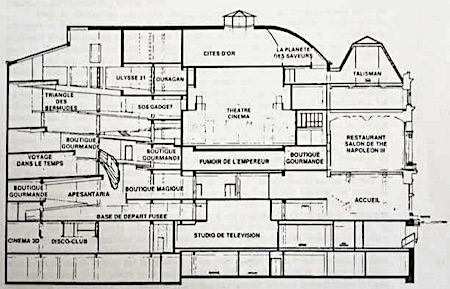 |
Visitors were to follow a spiral circuit around a large inner courtyard, with many adjoining rooms, and a large number of (hi-tech) attractions and activities, like a futuristic rollercoaster or robots serving drinks in a bar.
The Apesentaria (second floor) is a rail along a closed circuit, and a nearly vertical wall. ‘Astronaut seats’ are suspended, with a number of controls to participate in interactive games or rotate with the seat, e.g. around the horizontal axis, so that one finds oneself leaning forward, only retained by the belt above a vacuum corresponding to the height of several floors.
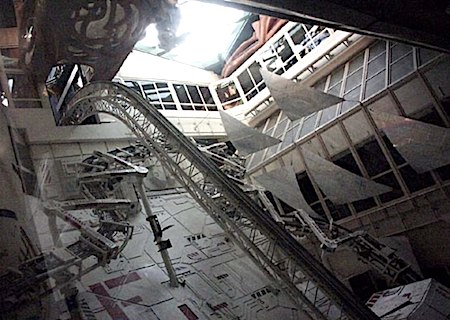 |
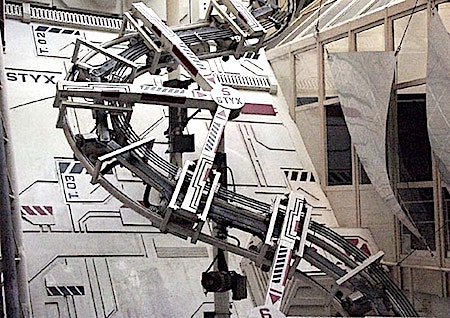 |
On the sixth floor the visitor would experience a virtual hurricane (Ouragan), with loss of spatial orientation, vibrating seats etc. Elsewhere on the sixth floor one came upon an interactive laser game, the Talisman.
On the third floor there was the Machine à Voyager dans le Temps, the Time Machine - basically a rotating elevator leading to rooms dedicated to Egypt, ancient Greece, Leonardo da Vinci, et cetera. Vecteur Beauté (Beauty Vector, sponsored by Yves Rocher) used digital photography for make-up simulations on screens. And also on the third floor was Barbie's House, sponsored by Mattel.
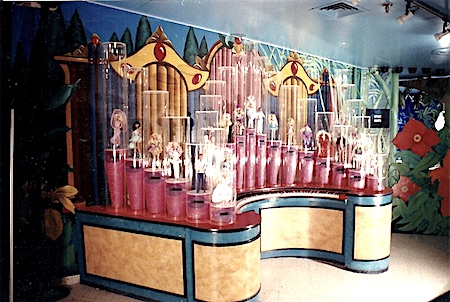 |
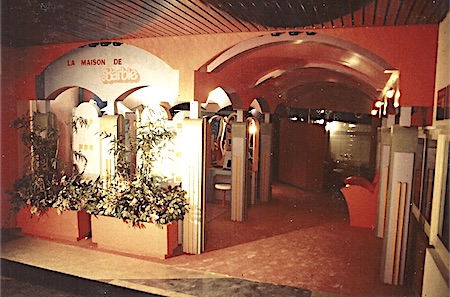 |
The fourth floor was home to a theatre hall for performances, with 350 seats; on the second floor there was Le Bouquet a set of performing music automatons; and so on, on, on, on, on... (There are more pictures on the web site of the Atelier Thierry Loubry, that constructs sculptures and decorations and apparently at the time worked on the Planète Magique attractions.)
In the amusement park's first days after opening its doors to the public - some sources say: three weeks, others say: twelve days - the Planète Magique drew 30,000 visitors.
And right after, it closed its doors again.
Only half finished, the Planète Magique was a big disappointment to most visitors. Many of the attractions were not functioning, or only haphazardly, as they were continuously plagued by breakdowns and errors. At the time much of the new technology that was put to use was not yet reliable and stable enough to fulfil the heavy-duty tasks asked from them in the amusement park.
The Planète Magique's 90 employees lost their jobs, and the invoice of some 80 companies remained unpaid. Estimated at (the equivalent in francs of) about 61 million euros, the construction costs had far exceeded the original estimations and budget. In order to prevent an imminent financial disaster, not in the least for itself, the city of Paris agreed to a relaunch of the site with a new investor, who was to cover the some twelve million euros worth of unpaid bills. Also, the city put up another ten million euros as a new guarantee.
With a new line of shops, restaurants, a conference hall, daily radio broadcasts and extended opening hours, a small year later, on December 8th 1990, the Planète Magique opened for a second time. But then definitely closed some monthe later, in June 1991. The technical failures persist, in weekends and holidays the centre does not have enough capacity to welcome all visitors that want to get in, while on weekdays there's but some handsful of them.
Ticketing turns out to not even cover the employees' salaries.
...
For another ten years, the building stayed closed, with its curious novel inside remake degrading.
In 2001 the city of Paris's new mayor, Bertrand Delanoë, imagining his town soon taking the lead in a European media art network, decides to once again transform the majestic building: it should become a major cultural centre, dedicated to digital art and musiques actuelles ( ** ), in the spirit of centres like, for example, the ZKM (Zentrum für Kunst und Medientechnology) in Karlsruhe, Eyebeam in New York or Ars Electronica in Linz ( *** ).
In preparation, in 2002 the building reopens on and off for divers artistic means, many of them organized and led by artists and volunteers, and every now and then guided tours were organised, taking small groups of visitors on a tour of the abandoned amusement park and its no longer functioning and badly degrading attractions. It is in this period that I discovered the building, its history and the Planète Magique, when in 2003 from Friday July 25th to Tuesday July 29th the 72 hour non-stop final event of the sixth edition of Erik Minkkinen's international headphone festival Le Placard took place in La Gaîté Lyrique.
It must have been also around this time, or a little later, that most of the images in the following video were shot.
Between 2002 and 2004 the only vaguely organised and sometimes barely authorised volunteer groups that went in and out, began dismantling of what still remained of the attractions, work that was then taken over by professionals in 2004. The official works for the new cultural centre began in 2007. It opened its doors in 2011.
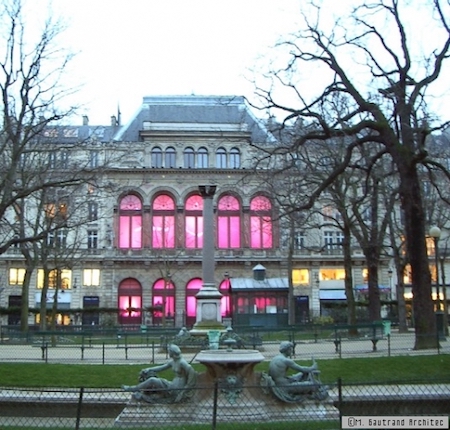 |
__La Gaîté Today__
[as] « I will start by giving you a tour of La Gaîté, and after that my colleague [Rachida] will be able to give you an English introduction to our current exhibition, Capitaine futur et la supernature, that you then after can visit on your own. »
[...]
Centre de ressources (first floor)
« As you already have heard quite a bit of that, I will be quick on the history of this place. But I do want to say a few words also about that. Euh, the centre and the building as they are now opened in 2011. 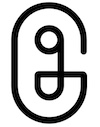 But before that date euh the Gaîté Lyrique originally was an operetta theatre built in euh 1872. And it continued to be, say, the Parisian temple of the operetta until the 1960's. Then, as you already know, the operetta theatre transformed, most notably into an indoor amusement park in the 1980's, that, unfortunately, had to close its doors again very quickly. As a result, the site was abandoned for more that 20 years, until its re-opening in 2011, and eh at the time it was the then mayor of Paris, Bertrand Delanoë, who wished to re-open La Gaîté. So eh this project then was conceived as euh the idea was to create an artistic and cultural centre at the crossroads of artistic creation, of technology and of social issues. And rather than being interested in technology for technology's sake, we developed a project that looks through the eyes of artists at how technology disrupts our society, at our way of perceiving the world, our way of communicating , uh at how we work, et cetera. So the idea is that we're not simply a hi-tech place, we're really more of a place for creation and a place where we try to, to ask questions about our present and our future, uh thanks to artists' views. As a result, we see our project as being multidisciplinary, with both a programming of concerts, exhibitions, festivals and that of conferences, debates, film projections uh, workshops programs, of workshops uh and this very dimension of spectacle, as you also will encounter quite a few performances here. So, in fact, we uh meet all thinkable artistic fields, and all artistic fields can meet ... graphic design, architecture, music, film, performance, dance... So here we have both a role of support for creation, uh and we have notably artists that come here in residence, and a role of, of diffusion. We welcome projects that have already been created uh to support their dissemination.
But before that date euh the Gaîté Lyrique originally was an operetta theatre built in euh 1872. And it continued to be, say, the Parisian temple of the operetta until the 1960's. Then, as you already know, the operetta theatre transformed, most notably into an indoor amusement park in the 1980's, that, unfortunately, had to close its doors again very quickly. As a result, the site was abandoned for more that 20 years, until its re-opening in 2011, and eh at the time it was the then mayor of Paris, Bertrand Delanoë, who wished to re-open La Gaîté. So eh this project then was conceived as euh the idea was to create an artistic and cultural centre at the crossroads of artistic creation, of technology and of social issues. And rather than being interested in technology for technology's sake, we developed a project that looks through the eyes of artists at how technology disrupts our society, at our way of perceiving the world, our way of communicating , uh at how we work, et cetera. So the idea is that we're not simply a hi-tech place, we're really more of a place for creation and a place where we try to, to ask questions about our present and our future, uh thanks to artists' views. As a result, we see our project as being multidisciplinary, with both a programming of concerts, exhibitions, festivals and that of conferences, debates, film projections uh, workshops programs, of workshops uh and this very dimension of spectacle, as you also will encounter quite a few performances here. So, in fact, we uh meet all thinkable artistic fields, and all artistic fields can meet ... graphic design, architecture, music, film, performance, dance... So here we have both a role of support for creation, uh and we have notably artists that come here in residence, and a role of, of diffusion. We welcome projects that have already been created uh to support their dissemination.
And there is a third dimension that might not have been part of the original plan of the city of Paris. That is that the La Gaîté Lyrique has a big social function, it became a place euhhhhhh for people to socialize, a community place, where one does not only come to see an exhibition or a concert, but also to come to work, to consult books and other resources, where one has appointments, where one comes to drink a coffee at the bar, or sometimes even to take a nap... Euh voilà.
So let's make a quick tour of this floor, before moving on to the second one.
[...]
Uh, so here we are in our center of resources that is a bit like a multimedia library. It is a space where everyone can come and that everyone can make use of, free of charge. »
[hs] « And there is free internet? »
[as] « Yes absolutely. There is a Wifi access. And we have a large corpus of quite specialized books on uh digital cultures, and uh others that are more for the general public. All of these can and should be consulted and who is consulting on site. You can not borrow the books, the video's or any of the other resources. On the tables over there you can see a number of desktop computers with internet connection, uh since there are still a lot of people in Paris uh who do not have internet, who do not have an internet subscription, so it's a free service that we offer, with one hour sessions. And uh, on this side we have a workshop space, with at the moment a workshop related to the Capitaine futur et la supernature exhibition. It's a workshop where the children can make euh interactive origami, which is related to one of the works in the exhibition.
Uh, and in this space here, we have uh, it is dedicated to kids. On the tablet computers they find a selection of creative applications uh that they can use for free, uh, also related to the exhibition. There is a selection of books for children, also related to the exhibition. And the big screen over there, is basically a touch screen that allows access to selections of animations for children, also related to the theme of the exhibition. So if you have some time later, after your visit to the exhibition, you can come and sit here. The idea is that those who have visited the exhibition, afterwards come and spend some time here, and then further explore the things they encountered in the exhibition. »
[student] « So, with each new exhibition, you will renew all content. »
[as] « Yes, indeed. »
[student] « Okay, and I understand you also do a workshop in connection with, euh... »
[as] « A program of workshops. And this time there is a program of eight workshops. »
[student] « And these are organised by La Gaîté Lyrique? »
[as] « Yes, yes. It's La Gaîté Lyrique, yeah, yeah. The programming of the workshops, as a matter of fact, uh, for us is an integral part of the artistic programming. It is thought of and constructed fully in coordination with uh with artists. »
[student]« And who is teaching, who is leading the workshop? »
[as] « This particular workshop, it is led by an association called Les Petits Débrouillards, uh, because there, there is something rather uh technical and specific about this workshop, so we 'uh have entrusted the task of running the workshop. But most of the time, it is artists who lead the workshops. The artists of the exhibition or festival, or artists that are here in residency. It is an association dedicated to scientific and technical culture.
[...]
So, and indeed, the selection of applications, uh books, workshops and video games - we have a video games area - changes regularly, depending on the current exhibition, or festival, et cetera. »
[student] « Ah, but that must be expensive! »
[as] « No, not thát expensive, really... No, no, it's uh, it's done with uh, we have a team of three documentalists who, so it's their job. And for the workshop part uh, it's the public relations team who uh, who devises these and who uh who implements them with artists. So uh, not that expensive, no.
Also, there are both free workshops and paid workshops.
And also, with respect to the workshops, uh, there's also uh, how do you say, there are workshops that are related to the artistic programming, like this one, uh, and they are temporary, at the same time as the event that they are linked to. But then there are also some regular workshops, which take place all year long... uh, for example ... let us go to the video game space ...
[...]
Uh, so, uh, here we have our selection of video games, that has also been made by the documentalists. And so, these are video games that are related to the exhibition. And as I said, there is a whole workshop program also associated with this. For example, uh, every Thursday afternoon we do a workshop called Game Older, that rather is dedicated to people of a generation that is not used to playing video games, but who want to learn about video games. The workshop is open to all, but this time there are only women who have registered. There are uh, twelve people, who are between 50 and 70 years old and who come every week play our selection of games, which changes every fifteen days. They also get small uh, small lessons on the economy of the video game industry, the video game trades, the process of producing a game, et cetera, so that they also learn about uh, that side of this artistic field.
But so the idea uh, both on the video game side and the application side is to have visitors discover content, uh, that is but little known to the general public. With respect to video games, we will not present the big blockbusters, uh of the industry, we will rather look for games made by artists, produced by independent studios, and games that are still in a prototype state. So indeed we want to show that, here at the Gaîté Lyrique, we really do consider the video game as an art in its own right. Similarly, regarding applications, we will not show the application-tools that we already use most of the time time. We try to show applications that allow one to enter into a relationship with 'the creative'.
Voilà. And as you can see, also paper still has its place here. And it's very important to us, um, to show also to the youngest ones, to children, to teenagers, that, um, it's even more interesting to, to play with an application if before we have looked through a book on the same theme, or if for example we saw a movie that echoes what's the application is about. And that, uh, it's not because we love to play video games, or applications on our tablet that we can not also love uh, looking at and reading a book.
[...]
We'll now walk up to the bar, and then we'll move up to the second floor.
[...]
So, here we are at the bar, in the bar of La Gaîté. So here it's like in a cafe. We can come for a coffee, drink a beer, uh, it's also a place where we can have lunch since for lunch, we have an offer, with the Trois Bis on the ground floor. So you can come here for, uh, to eat, uh, and it's also a space where we organise, about two or three times a week, conferences or meetings. And these are free. ( **** ) »
[hs] « It is very crowded, indeed. But what strikes me particularly is that at this very moment every single person here in the bar seems to be working on, or at least using, his or her laptop ! So it's not really your thread-of-the-mill Parisian street bar or cafe... »
[as] « Well, yes, we have free Wifi! And we're uh, the people have to take a coffee to be allowed to sit here, but it's rather relaxed, we're not... »
[hs] « But what interests me, are they really all working? Did all of them came here to work? »
[as] « Yes, they are working. It's mainly young professionals, young professionals who are uh, freelance, or students, too. But it's important to say that here it is not a co-working space. »
[hs] « And the drinks are not free. »
[as] « No, drinks are not free. Not at all. Ouais; so, that's it, we're not, uh, and actually, uh, we can... for example, last night, there was a conference/meeting around Design Fiction, and so, there are people who talk in the microphone, uh, round tables, debates, and so it's not a quiet space, it's a space for programming, of life So, voilà ... »
[hs] « Are the bar and restaurant an important source of income for La Gaîté? »
[as] « Eh, not the bar here, but the second floor bar, um, which is open on concert nights, yes. This bar is more for the conviviality of the place. But, eh, I really invite you to take a look at the program of meetings and conferences, because there are really super interesting things. We have a cycle on video games called Ère de jeux, a whole cycle on Design Fiction . So how can we design our future differently [speculative design]. So, here you go, there are extremely different cycles, there are some things really interesting, uh, so do not hesitate to take a look on the, our web site in the Meetings section, there's really an awful lot of things. »
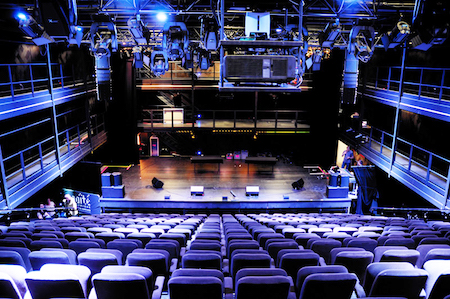 |
Concert Hall (second floor)
[as] « Let me see if we can have a look inside the big hall...
[...]
So here we are in what we call la grande salle, the big hall, which is where our concerts take place, uh, but also shows, conferences, screenings... But the bulk of the activity in this hall, is still concerts. We have 80 to 100 concerts per year, concerts of all sorts of current music, but essentially it is electro, pop, hiphop et cetera. »
[hs] « Mainly of the electronic kind? Or is it not only electronic music? »
[as] « Not only. There's rock, experimental music, R&B... It is varies quite a bit. »
[student] « You have also performances, but for the performances, it is obligatory to have a digital thing or something techno ...? »
[as] « So, in fact, as I already told you at the beginning of our little tour, we are interested in how artists can help us better understand our changing world. So, that is not necessarily artists who will use technology on stage, it is artists who in their work, uh, bring us meaning that relates to these evolutions. So there do not necessarily have to be sensors on stage, or interactive stuff. Sometimes there is, and sometimes there's not. However, the subject matter, the cultural matter or the cultural context that is questioned by the performance will be that of our digital society.
And so, here in the back we have hidden tiers, that we can open as an accordion and allows us to accommodate 300 people seated for some of the shows, like shows for children, because we have a whole Capitaine futur program for kids.
And what is quite special about this hall is that it is equipped with screens, in fact, which are like blinds, that can be unrolled all around, along all of the walls. And so, we can, uh, make 360-degree projections. And I invite you, for example, to come and attend the concert of Cascadeur that will be taking place here on May 16th, if you like this artist. he is going to use this 360-degree device. Oh, and I forgot to tell you: the hall can take 750 people standing up...
[...]
Uhh... now we're going to visit the foyer historique.
»
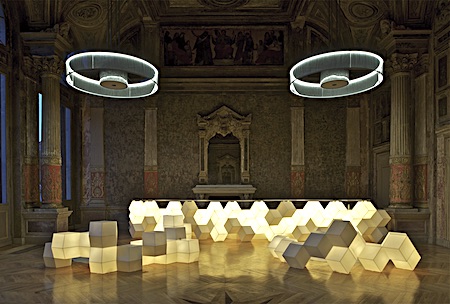 |
[as] « Voilà, so here we are in the bar of the historic foyer, which is actually a room that dates from the time of the original Gaîté, where people came during the intermissions of the operettas. And so today, it has become the bar of the foyer, which is open on concert nights, on the evenings of shows and also every weekend from noon till 7pm, uh, with a brunch which is proposed on Saturdays and Sundays. »
[hs] « So this is one of the rare historical parts of the building that was not destroyed to make place for the Planète Magique attractions. »
[as] « Yes, indeed. And for the record: in 1882 Victor Hugo celebrated his 80th birthday in this very same space.
[...]
Uh, So I am not going to show you all the other floors, because that would really take a lot of time and uh, you will go see the exhibition and I would like us to talk a little bit about, maybe the economic model? »
[hs] « Yes. But then before you do so, let me ask - because I heard some of the students do so - how many spaces are there in total in the building? »
[as] « OK, but let us then go into the hall, to not be bothered by this loud humming sound of the fridge
[...]
Uh, so in fact, we are, uh, we have in all seven floors. So this is a building that is all vertical, like all old 19th century theaters. And, so on the upper floors, we have one floor that accommodates all our training activities, since we have a professional training catalog here for artists, for technicians, euh, who want to train themselves ... on the, it can be in virtual reality, in video mapping, in ... »
[hs] « And anyone can enroll in these classes? »
[as] « Yes, but it formation continue, continuing education. So that is quite expensive. And one has to find one, has to have the funding for...
But we are also an educational insititution.
Uh, and then higher up still, there are, uh, our offices, so all, so all the teams of La Gaîté that work here, and both, uh, both the last two floors are floors that are dedicated to artists uh, who are here in residence, uh, we have studios, a rehearsal studio, multimedia studios, um, and uh, workspaces, also a recording studio too, and we also... a part, uh, of these spaces are offices that are rented to, to collectives of artists, or uh, to production companies, to agents, voilà.
Uh, so, we are, uh, both dealing in artist residencies, and in the rental of work space for professionals of the sector, let's say. With rates that are quite, uh, interesting, uh, not too much, not too expensive, given that this is a wonderful and very central spot in Paris to have one's office, euh... »
[hs] « So is there something free at the moment? Can we rent something? »
[as] « Yes, absolutely, for the artists. That is to say that, in fact, we make a difference. When we as the La Gaîté Lyrique are interested in an artist, if we want to support him and accompany his project, we will welcome him for free, and we are going to offer a technical support. But if someone is asking us because he wants to come to work at La Gaîté to be in this place because it interests him, but we, we do not necessarily have an artistic interest in him or his work, then we will rent him a workspace. »
[hs] « Yes, but are there spaces available at this moment? »
[as] « Yes there are. There are some spaces available. Not many, but we're not full. »
[student] « So for example, if I am a video game developer and I do not have an office in Paris, then here I can rent, I can install my office here? »
[as] « That's right. »
[student] « And then how much would that cost, the rent? »
[as] « The rent is 300€ per month. »
[student] « So that is just for a work place. Can you say if there is also a room a little bigger than you can rent, to have an event? »
[as] « It is for a work place, for a desk. But one then can also use the meeting room, which is a shared space. »
[student] « But is it also possible, for example, to use the recording studios and all that, or are these only for the artists? »
[as] « You can have access to the recording studio but you'll have to rent it.
[...]
Uh, so then about our economic model: we, La Gaîté Lyrique, we are a private company, and we have what in France is called a délégation de service publique, a DSP, with the city of Paris. So the peculiarity is that, uh, the city, under the DSP contract that goes until 2022, gives us a financial participation that corresponds to a little less, uh, let's say there, we is, because it has dropped a lot over the last two years, but it's less than half, um, of our overall budget. »
[hs] « So this means you will have to fill in that second half yourself. »
[as] « Voilà, so the other part has to be generated by us, through resources, so obviously the ticketing revenue, uh, knowing that we need to have prices that are accessible, since we are funded by the city, uh, the turnovers of the bars, beer is a, a non-negligible resource for La Gaité, uh, the privatisation of our spaces, and then all that is partnership, sponsorship, patronage, uh, the co-production of an artistic project with brands or with the private sector. »
[hs] « That is to say, privatisation of spaces, is that only the two floors you mentioned, or is it more? »
[as] « It is often this here second floor that we privatise, the big hall and the foyer, but we can also ... »
[hs] « So it is possible to rent the concert hall for a performance or concert. And are there any conditions then on the type of concert? If I would come to you to rent the hall, will you look at the content of my project, of what I am going to do there? »
[as] « From the moment the event is open also to our public, we have a right to look, we make choices. We can rent the room to an agent but only if the concert will fit in with our artistic direction. But if it's a private concert, uh... »
[hs] « But in a place like La Gaîté, what does private concert mean? »
[as] « That means that, for example, a brand wants to organize an evening for its network, for its customers, for ... it's on invitation. »
[student] « And how big is your budget? »
[as] « It is nine and a half million euros. »
[hs] « That then is the same as what it was when you opened in 2011. With 5,45 million coming from the city of Paris. »
[as] « It was the same budget. But the city's participation was higher. We lost one and a half million in two years. And so we have to do, in fact we must, we have the same objectives in terms of the number of events. The city gives us objectives, we have to do so much concerts, so much shows, so much projections, so much conferences, so many workshops, um, and... With less money from the city. So we have to find solutions, at the moment, we are in a period where our we try to adapt our business model to find solutions that will help us reach our objectives, uh, by finding new resources. And so the peculiarity of this place is that we have public service objectives. For example, we have to propose, um, to be a place that supports creative creation, uh, in the fields of digital cultures, and we need to be a place that is open to all the public, we have to do a lot of work to raise awareness among the public not in the habit of frequeting a place like ours, through projects, through workshops, meetings, mediations, uh, so we have all these dimensions that are very public service oriented, and at the same time we have to generate resources. So we are really in a completely hybrid situiation, um, with a real private identity but also with a very real public function.
And we are, uh, today we are, uh, 54 permanent members working here in the team, including the technical teams, the bar teams, production, communication, programming... With a large number then also of contract workers that are hired whenever they are needed. »
[student] « Could you tell us a bit more about the reflections or possible solutions that you are thinking about when adapting or when adapting or having to adapt your business model? »
[as] « We are reflecting and thinking about how to produce artistic programming in different ways, that is, without producing all 100 per cent by ourselves. It is getting increasingly difficult to find co-producers from other cultural institutions, uh, and also in a way to find sponsors and patrons. Patronage works well in contemporary art, it works well in domains of cutural heritage. So, for example luxury brands are supporting a great many artistic fields. But we are active in domains that are much more emergent, less stable and less rewarding and for us the patrons are more fluid. So, we rather try to think about looking for partners. I will give you an example. For this autumn we are working on an exhibition with Ubisoft and we are somewhere on the border between renting our spaces to them for organising an exhibition and a co-production, that is to say, we, we will work with them as if we were a bit like an agency that accompanies them in the way they adapt the content of their exhibition to our public so that it works well, which is a good mediation, so that the exhibition will be well built, well articulated, so that it can meet a wide audience. And they, they are looking for some sort of, how to say, a cultural endorsement by coming here. They do not want to talk to the gamers, they want to reach a large cultural audience, and we, uh, that is what we offer them, we have an engineering, teams that will work on the project and they, they have quite substantial means, and so, we're trying to find formats like that, that allow us to produce artistic projects that are on the border between eh..., we're not going to do that, we'll continue to produce things, ourselves, but if we want to continue to have this many expos, this many events, we are obliged to, I think to continue by way of this type of somewhat hybrid projects. »
[student] « And will it not pose a problem when you tie yourself up with a company like Ubisoft, while you have a public function or you are a public institution? »
[as] « The city of Paris gives us the most money. And we, we will take a develish pleasure in creating a program parallel to the exhibition that is not necessarily critical but in any case, uh, we will push Ubisoft for, they will not make the promo of their games here, we will really take them to show us the stages of the making of their games, show us the know-how, provide content and meaning for the public and not only spectacle... I'm not saying that we will succeed. It's experimental, we never did this before. And we know very well that they do it for corporate reasons. We do not have the same goals, so voilà, but we'll try, I think that this may be a good way.
So, after, where it gets complicated is on the artistic side and the artists that we can invite. We can play on the notoriety or on, they're a very big studio, so they will invite, they will highlight games that work, teams that are known in the video game industry, and it's true that we are more likely to try to get them to discover perhaps the less known things that they do in their studio, rather th things, maybe a little more alternative. So, here, we are really insisting on emergent things, so we can not really rely on a big artist's reputation, even though we do that every now and then, like, we'll have the band Phoenix doing a series of 5 concert dates at the end of May, they call it Ti amo Paris, because they have been in residency here for 2 years. They squatted our recording studio for 2 years to make their album. So we have this possibility because we created this link of complicity between us, it's their home here, so we can do this series of 5 dates, but normally it's clear that we can not. So, we're really on a line, anyway, at the level of notoriety of the music, we're going to say that artists who are on their way up up, and who have, voilè, who are uh ...
[...]
Well, I'm sorry, but I will have to leave you. There's my colleague waiting for you downstairs to plunge you into the Capitaine futur!
[...]
And for fun, we'll go down the concert stairs, so you can see the difference...
»
notes __ ::
(*) Sources: http://fr.wikipedia.org/wiki/Planète_magique, accessed April 2018 ; the wikipedia text is pretty much identical to that of http://gaitelyrique.free.fr/site/1986.htm[, accessed April 2018. [
^ ]
(**) Musiques actuelles ('current musics') is a French 'bureaucratic term', which, roughly spoken, refers to all kinds of music that use electr(on)ic amplification in performances, 'amplified musics'. [[ Source: http://fr.wikipedia.org/wiki/Musiques_actuelles, retrieved May 2018 - "Musiques actuelles est une appellation non contrôlée, utilisée par le Ministère de la Culture lors de la création de La Commission nationale des musiques actuelles, le 7 décembre 19971 puis par la Circulaire du 18 août 1998 sur les SMAC, avec la mise en place du soutien apporté par l'État aux Scènes de Musiques Actuelles remplaçant, le programme Cafés-Musiques initié en 1991. Le ministère reconnaissait ainsi des pratiques musicales populaires qui « n'étaient pas, ou étaient insuffisamment prises en compte, dans les politiques publiques ». Cette reconnaissance s'inscrit dans une histoire plus longue qui débute avec l'arrivée du rock en France à la fin des années 1950.
L'expression Musiques actuelles a été utilisée en l'absence de consensus de l'ensemble des membres de la commission pour une autre appellation : « musiques plurielles, populaires, amplifiées, contemporaines, vivantes... », tout en étant conscient des différences entre les genres musicaux qu’elle englobe (jazz, rock, chanson, musique traditionnelle, rap, techno ou musiques électroniques) et des implications sociales des groupes sociaux concernés." ]] [
^ ]
(***) Cf. Heiko Hansen. 'Theatre of History'. Cluster 03 (2004) [
^ ]
(****) As one among many examples: the Soundkitchen event that I remember attending in the Gaîté public bar space on December 13th, 2015... [
^ ]
tags: La Gaîté Lyrique, pamap18
# .477.